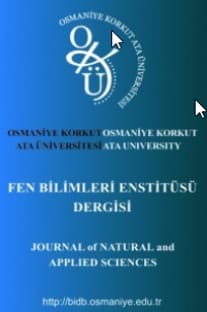Çok Robotlu Üretim İstasyonlarında Çarpışma Olmaması İçin Çalışma Alanı Yönetimi
Workspace Management in Multi-Robotic Stations for Collision Avoidance
___
- [1] Pan Z., Polden J., Larkin N., Van Duin S., Norrish J. Recent progress on programming methods for industrial robots, Robotics and Computer-Integrated Manufacturing 2012; 28(2): 87-94, doi: 10.1016/j.rcim.2011.08.004
- [2] Neto P., Mendes N. Direct off-line robot programming via a common CAD package, Robotics and Autonomous Systems 2013; 61, 896-910. doi: 10.1016/j.robot.2013.02.005
- [3] Baizid K., Cukovic S., Iqbal J., Yousnadj A., Chellali R., Meddahi A., Devedzic G., Ghionea I. IRoSim: Industrial robotics simulation design planning and optimization platform based on CAD and knowledge ware technologies, Robotics and ComputerIntegrated Manufacturing 2016; 42, 121-134. doi: 10.1016/j.rcim.2016.06.003
- [4] Curkovic P., Jerbic B., Stipancic T. Coevolutionary algorithm for motion planning of two industrial robots with overlapping workspaces, International Journal of Advanced Robotic Systems 2013; 10(55): 1- 11. doi:10.5772/54991
- [5] Flordal H., Fabian M., Akesson K., Spensieri D. Automatic model generation and PLCcode implementation for interlocking policies in industrial robot cells, Control Engineering Practice 2007; 15(11): 1416-1426. doi: 10.1016/j.conengprac.2006.11.001
- [6] Rubio F., Llopis-Albert C., Valero F., Suner JL. Industrial robot efficient trajectory generation without collision through the evolution of the optimal trajectory, Robotics and Autonomous Systems 2016; 86, 106-112. doi:10.1016/j.robot.2016.09.008
- [7] Peidro A., Reinoso O., Gil A., Marin JM., Paya L. A method based on the vanishing of self-motion manifolds to determine the collision-free workspace of redundant robots, Mechanism and Machine Theory 2018; 128, 84-109.
- [8] Villani V., Pini F., Leali F., Secchi C. Survey on human–robot collaboration in industrial settings: Safety, intuitive interfaces and applications, Mechatronics 2018; 55, 248-266. doi:10.1016/j.mechatronics.2018.02.009
- [9] Schmidt B., Wang L. Depth camera based collision avoidance via active robot control, Journal of Manufacturing Systems 2014; 33, 711-718.
- [10]Zhou J., Aiyama Y. On-line collision avoidance system for two PTP commandbased manipulators with distributed controller, Advanced Robotics 2015; 29(4): 239-251. doi:10.1080/01691864.2014.985610
- [11]Danaei B., Karbasizadeh N., Masouleh MT. A general approach on collision-free workspace determination via triangle-to-triangle intersection test, Robotics and ComputerIntegrated Manufacturing 2017; 44, 230-241. doi: 10.1016/j.rcim.2016.08.013
- [12]Ruiz de Miras J., Salazar M. GPU inclusion test for triangular meshes, Journal of Parallel Distributed Computing 2018; 120, 170-181. doi: 10.1016/j.jpdc.2018.06.003
- [13]Ling-yu W. A faster triangle-to-triangle intersection test algorithm, Computer Animation Virtual Worlds 2014; 25, 553-559. doi:10.1002/cav.1558
- [14]Çakır M. Ders notu. Kocaeli Üniversitesi, Mühendislik Fak. Elektronik ve Hab. Müh. http://ehm.kocaeli.edu.tr/dersnotlari_data/mca kir/Mak_Collision/ 2010.
- [15]Möller T. A fast triangle-triangle intersection test, Journal of Graphic Tools 1997; 2(2): 25- 30. doi: 10.1080/10867651.1997.10487472
- ISSN: 2687-3729
- Yayın Aralığı: Yılda 3 Sayı
- Başlangıç: 2017
- Yayıncı: Osmaniye Korkut Ata Üniversitesi
İnsan ve Hayvan Beslenmesinde Chia (Salvia hispanica) Kullanılması
Entansif Şartlarda Yetiştirilen Kıvırcık Kuzularda Kan Plazması ve Yapağıdaki Çinko ve Bakır Profili
Hüseyin ESECELİ, Cüneyt KAPTAN, Harun KARADAĞ, Selim ESEN
Selim ESEN, Harun KARADAĞ, Cüneyt KAPTAN, Hüseyin ESECELİ
Turan ARSLAN, Mohammad Mahdi HOSSAİNY
Çok Robotlu Üretim İstasyonlarında Çarpışma Olmaması İçin Çalışma Alanı Yönetimi
Adana İlindeki Biyokütle Potansiyelinin Elektrik Enerjisi İkamesinde Kullanım Durumu
Arı Ürünlerine Genel Bir Bakış
Semiramis KARLIDAĞ, Merve KESKİN
Trafik Kaza Sayısının ve Yaralı Sayısının Yapay Sinir Ağları ile Tahmini
Ömer Faruk CANSIZ, İbrahim ERGİNER, Merve ERGİNER
Dolgu Duvarların Düzlem İçi ve Düzlem Dışı Davranışına Esnek Derzli Bağlantı Elemanının Etkisi
Osman Fatih BAYRAK, MUHAMMET MUSAB ERDEM, Murat BİKÇE, ENGİN EMSEN
Cam Tozu Katkılı Lifli Harçların Fiziksel ve Mekanik Özellikleri
